Everyday Science MCQs | Food Science MCQs
Vegetables are subjected to drying after:
(a) Sulfuring
(b) Sulphitation
(c) Blanching
(d) None of these
Answer: (c)
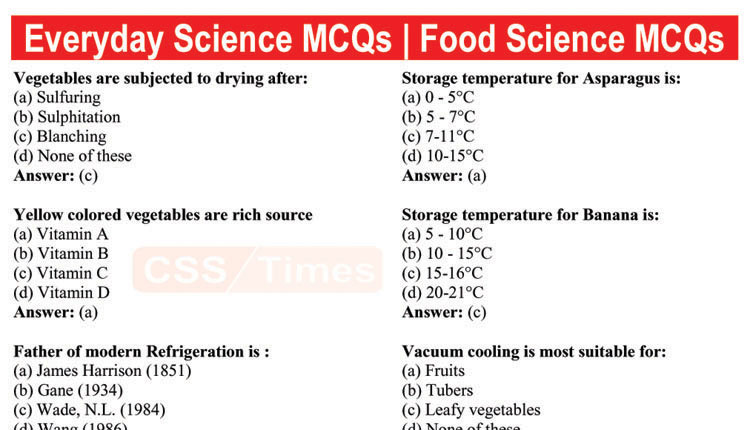
(a) Sulfuring
(b) Sulphitation
(c) Blanching
(d) None of these
Answer: (c)
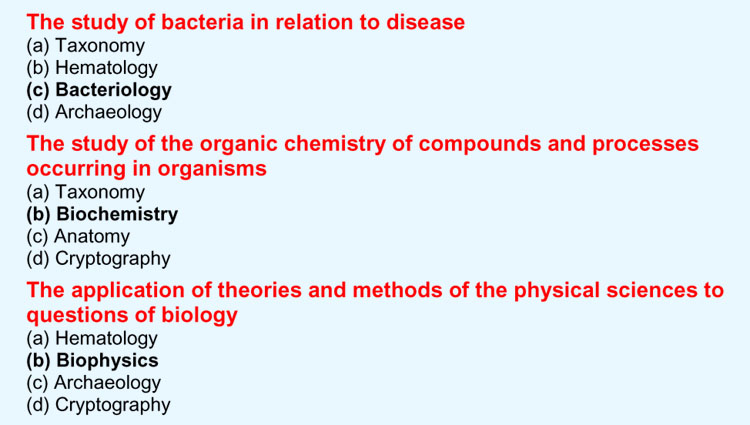
(a) Taxonomy
(b) Hematology
(c) Bacteriology
(d) Archaeology
Answer: c
(a) Taxonomy
(b) Biochemistry
(c) Anatomy
(d) Cryptography
Answer: b
(a) Hematology
(b) Biophysics
(c) Archaeology
(d) Cryptography
Answer: b
Read also: 50 Important Pakistan Studies MCQs
(a) Biology
(b) Taxonomy
(c) Anatomy
(d) None of these
Answer: a
(a) Hematology
(b) Botany
(c) Archaeology
(d) None of these
Answer: b
(a) Taxonomy
(b) Chemistry
(c) Anatomy
(d) Hematology
Answer: b
(a) Taxonomy
(b) Climatology
(c) Cryptography
(d) None of these
Answer: b
(a) Computer Science
(b) Hematology
(c) Taxonomy
(d) Anatomy
Answer: a
(a) Ecology
(b) Archaeology
(c) Hematology
(d) None of these
Answer: a
(a) Electronics
(b) Anatomy
(c) Cryptography
(d) None of these
Answer: a
(a) Hematology
(b) Engineering
(c) Archaeology
(d) Taxonomy
Answer: b
(a) Taxonomy
(b) Entomology
(c) Hematology
(d) Anatomy
Answer: b
(a) Taxonomy
(b) Forestry
(c) Cryptography
(d) None of these
Answer: b
(a) Taxonomy
(b) Genetics
(c) Hematology
(d) Archaeology
Answer: b
(a) Anatomy
(b) Taxonomy
(c) Hematology
(d) Geology
Answer: d
(a) Hematology
(b) Marine Biology
(c) Cryptography
(d) None of these
Answer: b
(a) Taxonomy
(b) Hematology
(c) Mathematics
(d) Anatomy
Answer: c
(a) Thermodynamics
(b) Taxonomy
(c) Meteorology
(d) Cryptography
Answer: c
(a) Microbiology
(b) Hematology
(c) Anatomy
(d) None of these
Answer: a
(a) Taxonomy
(b) Mineralogy
(c) Archaeology
(d) Hematology
Answer: b
(a) Hematology
(b) Taxonomy
(c) Molecular Biology
(d) Cryptography
Answer: c
(a) Hematology
(b) Nuclear Physics
(c) Anatomy
(d) None of these
Answer: b
(a) Neurology
(b) Taxonomy
(c) Archaeology
(d) Mineralogy
Answer: a | General Science MCQs
(a) Thermodynamics
(b) Anatomy
(c) Oceanography
(d) None of these
Answer: c | General Science MCQs
(a) Organic Chemistry
(b) Hematology
(c) Thermodynamics
(d) Taxonomy
Answer: a | General Science MCQs
(a) Taxonomy
(b) Paleontology
(c) Cryptography
(d) None of these
Answer: b | General Science MCQs
(a) Thermodynamics
(b) Taxonomy
(c) Hematology
(d) Petrology
Answer: d | General Science MCQs
(a) Physics
(b) Anatomy
(c) Cryptography
(d) None of these
Answer: a | General Science MCQs
(a) Taxonomy
(b) Hematology
(c) Thermodynamics
(d) Physiology
Answer: d | General Science MCQs
(a) Radiology
(b) Agronomy
(c) Hematology
(d) Anatomy
Answer: a | General Science MCQs
[catlist name=”MCQs”]
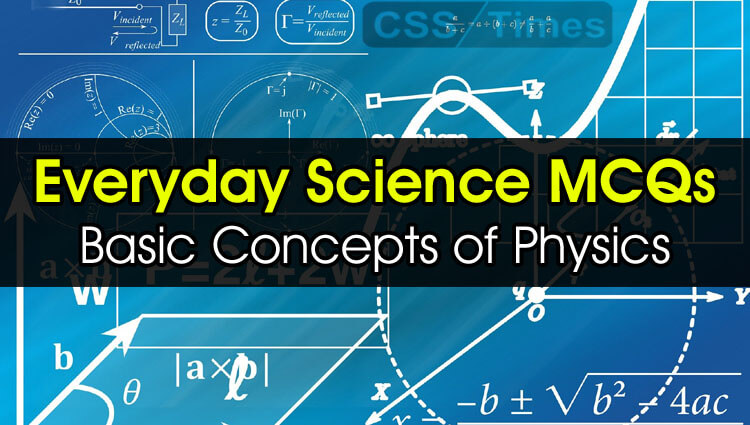
Which is the densest planet of our solar system?
(a) Sun
(b) Jupiter
(c) Mercury
(d) Earth
Answer:. d
A gradual rise in a barometer height indicates
(a) Approach of fair weather
(b) Approach of immediate storm
(c) Likelihood of rainfall
(d) Nothing significant
Answer: a
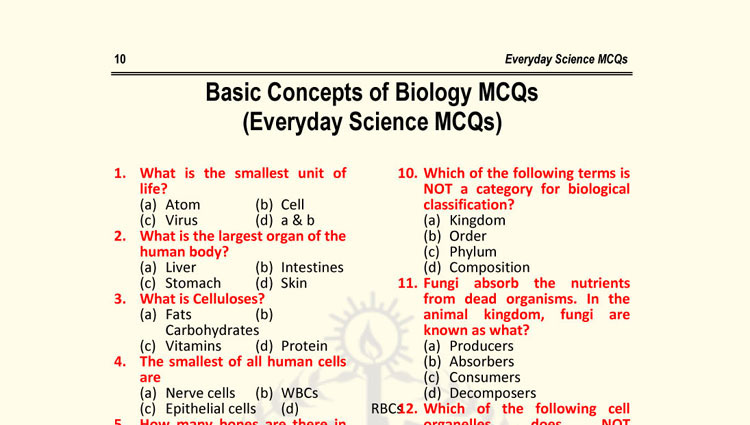
What is the smallest unit of life?
(a) Atom
(b) Cell
(c) Virus
(d) a & b
Answer: b
What is the largest organ of the human body?
(a) Liver
(b) Intestines
(c) Stomach
(d) Skin
Answer: d
What is Celluloses?
(a) Fats
(b) Carbohydrates
(c) Vitamins
(d) Protein
Answer: b
The smallest of all human cells are
(a) Nerve cells
(b) WBCs
(c) Epithelial cells
(d) RBCs
Answer: d
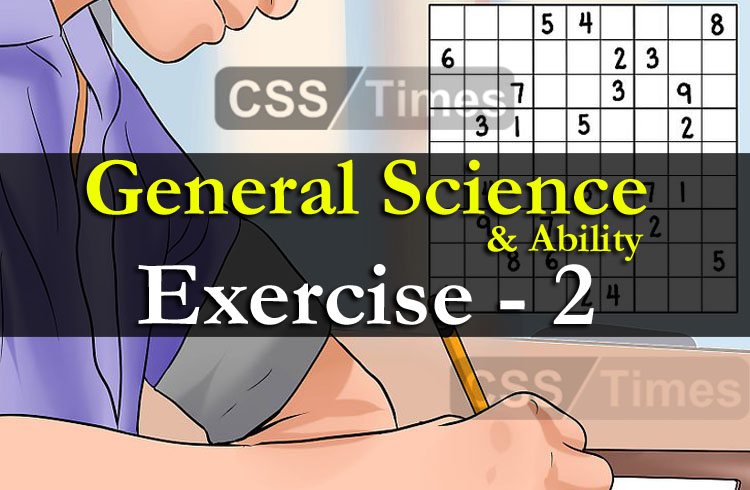
Why not test your brain and try one of our quizzes below. Once completed, click the Get Results button to see how you went.
[mtouchquiz 3]
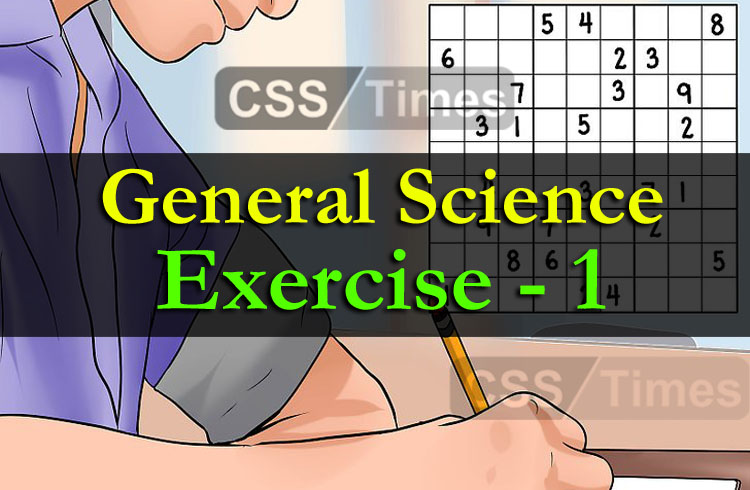
Why not test your brain and try one of our quizzes below. Once completed, click the Get Results button to see how you went.
[mtouchquiz 2]
Biological Science MCQs | General Science and Ability MCQs
Modern Materials/Chemicals | General Science and Ability MCQs
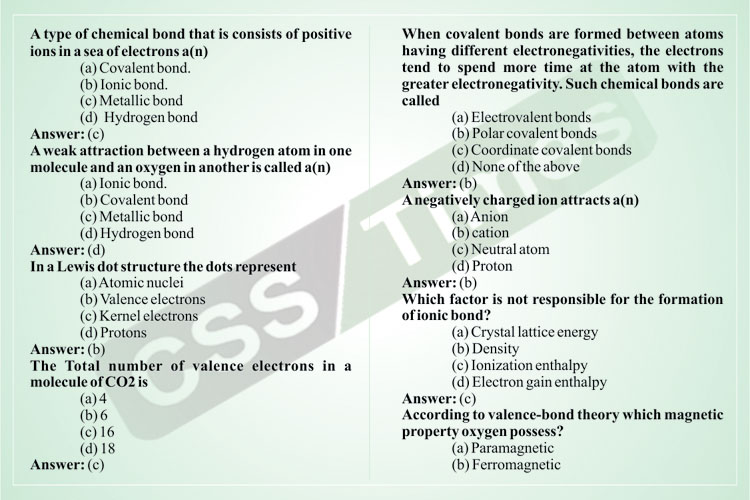
A type of chemical bond that is consists of positive ions in a sea of electrons a(n)
(a) Covalent bond.
(b) Ionic bond.
(c) Metallic bond
(d) Hydrogen bond
Answer: (c)
A weak attraction between a hydrogen atom in one molecule and an oxygen in another is called a(n)
(a) Ionic bond.
(b) Covalent bond
(c) Metallic bond
(d) Hydrogen bond
Answer: (d)
In a Lewis dot structure the dots represent
(a) Atomic nuclei
(b) Valence electrons
(c) Kernel electrons
(d) Protons
Answer: (b)
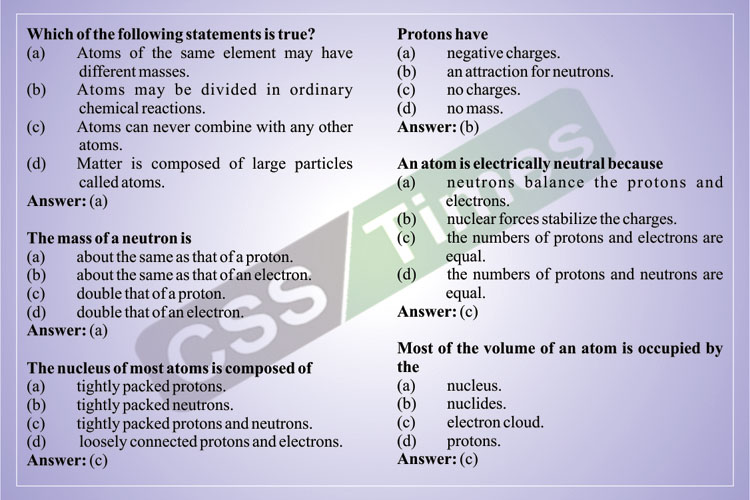
Which of the following statements is true?
(a) Atoms of the same element may have different masses.
(b) Atoms may be divided in ordinary chemical reactions.
(c) Atoms can never combine with any other atoms.
(d) Matter is composed of large particles called atoms.
Answer: (a)
The mass of a neutron is
(a) about the same as that of a proton.
(b) about the same as that of an electron.
(c) double that of a proton.
(d) double that of an electron.
Answer: (a)
The nucleus of most atoms is composed of
(a) tightly packed protons.
(b) tightly packed neutrons.
(c) tightly packed protons and neutrons.
(d) loosely connected protons and electrons.
Answer: (c)
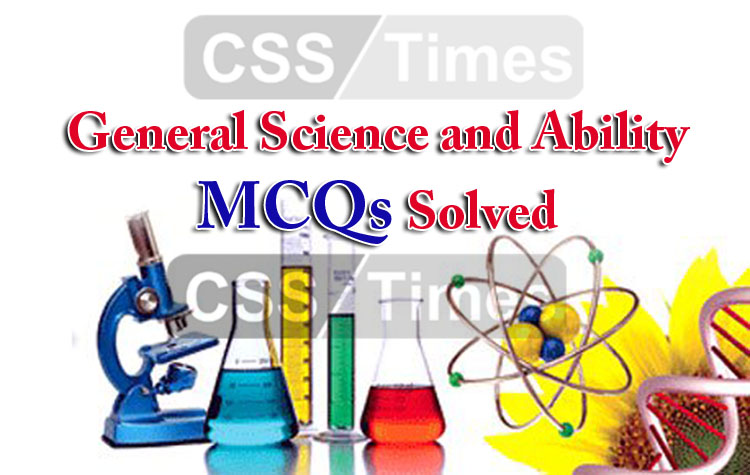
The nearest star to the planet earth is:
(a) Venus
(b) Sun
(c) Moon
(d) Alpha
Answer: b
Orion is a name of a ________.
(a) Star planet
(b) Planet
(c) Galaxy
(d) Constellation
Answer: d
The largest planet of the solar system:
(a) Mars
(b) Sun
(c) Jupiter
(d) Saturn
Answer: c